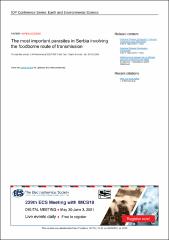| dc.contributor.author | Petrović, Jelena | |
| dc.contributor.author | Prodanov-Radulović, Jasna | |
| dc.contributor.author | Vasilev, S. | |
| dc.date.accessioned | 2021-05-26T09:11:21Z | |
| dc.date.available | 2021-05-26T09:11:21Z | |
| dc.date.issued | 2017 | |
| dc.identifier.issn | 1755-1307 | |
| dc.identifier.uri | https://repo.niv.ns.ac.rs/xmlui/handle/123456789/359 | |
| dc.description.abstract | Food can be an important route for transmission of parasites to humans. Compared
to other foodborne pathogens in Serbia, foodborne (or potentially foodborne) parasites do not
get the attention they undoubtedly deserve. The aim of this article is to give an overview of the
most important parasitic pathogens that can be transmitted by food, and that cause disease in
humans: Echinococcus, Trichinella, Taenia solium and Toxoplasma gondii. For each of these
pathogens, the severity of human diseases they cause, incidence, mortality and case fatality rate
among humans in Serbia as well as their prevalence in animal species in Serbia are described.
Some of the described foodborne parasites can induce severe disease symptoms in humans
associated with high case fatality rates, while others can cause massive outbreaks. All of the
aforementioned parasites occur throughout Serbia and cause both severe public health
problems and substantial economic losses in livestock production. In conclusion, the control
measures of foodborne parasites certainly need to include education of farmers and
improvement of veterinary sanitary measures in animal farming and animal waste control. | en_US |
| dc.description.sponsorship | This work was supported by the Ministry of Science and Technological Development of the Republic
of Serbia, grant TR 31084. | en_US |
| dc.language.iso | en | en_US |
| dc.publisher | IOP Conf. Series: Earth and Environmental Science 85 | en_US |
| dc.source | 59th International Meat Industry Conference MEATCON2017 | en |
| dc.subject | foodborne pathogens | en_US |
| dc.subject | Serbia | en_US |
| dc.subject | transmission | en_US |
| dc.title | The most important parasites in Serbia involving the foodborne route of transmission | en_US |
| dc.type | Article | en_US |
| dc.doi | 10.1088/1755-1315/85/1/012029 | |
| dc.identifier.doi | 10.1088/1755-1315/85/1/012029 | |

